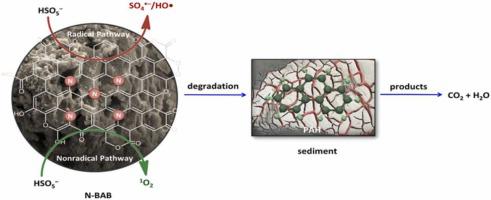Journal of Environmental Chemical Engineering ( IF 7.4 ) Pub Date : 2021-09-22 , DOI: 10.1016/j.jece.2021.106420 Chang-Mao Hung , Chiu-Wen Chen , Chin-Pao Huang , Cheng-Di Dong

|
A novel nitrogen-enrich biochar carbocatalyst (BAB) was derived from brown algal (Sargassum duplicatum) as precursor by direct pyrolyzation at 300–900 °C. Heteroatom nitrogen doping and the nitrogen functionality of the metal free carbocatalyst activated PMS and produced abundant reactive species (ROSs). BAB and melamine pyrolysis product (N-BAB) effectively activated peroxymonosulfate (PMS) that resulted in the radical and nonradical-based oxidation of 2- to 6-ring polycyclic aromatic hydrocarbons (PAHs). The catalyst N-BAB enabled 86% of PAHs removal in 12 h under optimal conditions ([PMS] = 1 × 10-4 M, [N-BAB] = 3.3 g/L, and pH 3.0), and 56, 72, 76, 82, and 70% removal of 2-, 3-, 4-, 5-, and 6-ring PAHs, respectively. The graphitization and nitrogen functionalization of biochar matrixes brought about rich defects and edges as radical/singlet oxygen-mediated oxidation sites, which resulted in enhancing the catalytic efficiency during PMS activation for PAHs degradation. The PAHs degradation were faster in N-BAB/PMS (observed rate constant, kobs, rate of 9.8 × 10-2 h-1) than in the BAB/PMS (6.6 × 10-2 h-1) system. Results of electron paramagnetic resonance (EPR) analysis revealed that both radical (SO4•- and HO•) and nonradical (1O2) pathways on the N-functionalized carbocatalyst facilitated PAHs degradation. The results showed also that N-doped biochar exhibited great potential in the remediation of sediment matrices and that the carbocatalyst-PMS process developed in the present study was highly efficient, simple to implement, and cost-effective for providing added value to natural biomass by using advanced biochar activation of PMS.
中文翻译:

来自褐藻(Sargassum duplicatum)的氮掺杂碳催化剂活化过氧单硫酸盐降解海洋沉积物中的多环芳烃
以褐藻(Sargassum duplicatum)为前驱体,通过在 300-900°C 下直接热解得到一种新型富氮生物炭碳催化剂(BAB)。杂原子氮掺杂和无金属碳催化剂的氮功能激活了 PMS 并产生了丰富的活性物质 (ROS)。BAB 和三聚氰胺热解产物 (N-BAB) 有效活化过硫酸盐 (PMS),导致 2 至 6 环多环芳烃 (PAH) 发生自由基和非自由基氧化。 在最佳条件下,催化剂 N-BAB 能够在 12小时内去除 86% 的 PAHs ([PMS] = 1 × 10 -4 M, [N-BAB] = 3.3 g/L 和 pH 3.0),2-、3-、4-、5- 和 6-环多环芳烃的去除率分别为 56、72、76、82 和 70%。生物炭基质的石墨化和氮功能化带来了丰富的缺陷和边缘作为自由基/单线态氧介导的氧化位点,从而提高了 PMS 活化过程中多环芳烃降解的催化效率。多环芳烃在 N-BAB/PMS(观察速率常数,k obs,速率为 9.8 × 10 -2 h -1)中的降解速度比在 BAB/PMS(6.6 × 10 -2 h -1)系统中快。电子顺磁共振 (EPR) 分析结果表明,自由基(SO 4 •-和 HO•)和非自由基(1 O 2) N-功能化碳催化剂上的通路促进了 PAHs 的降解。结果还表明,N 掺杂生物炭在修复沉积物基质方面表现出巨大潜力,并且本研究中开发的碳催化剂-PMS 工艺高效、易于实施且具有成本效益,可通过以下方式为天然生物质提供附加值使用高级 biochar 激活 PMS。











































 京公网安备 11010802027423号
京公网安备 11010802027423号